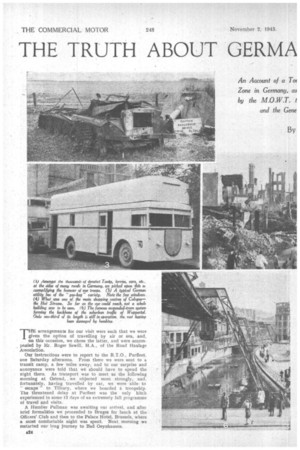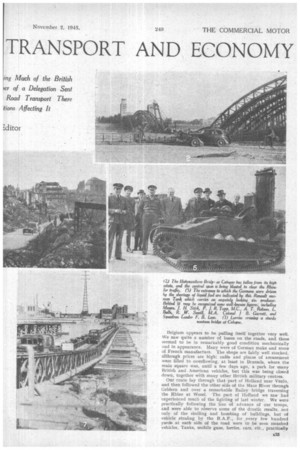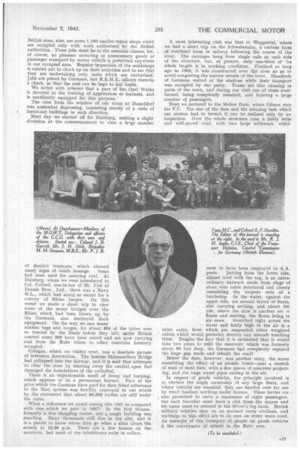THE TRUTH ABOUT GERMA TRANSPORT AND ECONOMY
Page 26

Page 27

Page 28

Page 29

If you've noticed an error in this article please click here to report it so we can fix it.
THE arrangements for our visit were such that we were given the option of travelling by air or sea, and, on this occasion, we chose the latter, and were accompanied by Mr. Roger Sewn" M.A., of the Road Haulage Association.
Our instructions were to report to the R.T.O., Purfieet, one Saturday afternoon. From there we were sent to a transit camp, a few miles away, and to our surprise and annoyance were told that we should have to spend the night there. As transport was to meet us the following morning at Ostend_ we objected most strongly, and, fortunately, having travelled by car, we were able, to
escape " to Tilbury, where we boarded a troopship. The threatened delay at Purdeet was the only hitch experienced in some 12 days of an extremely full programme of travel and visits..
A Humber Pullman was awaiting our arrival, and after brief formalities we proceeded to Bruges for lunch at the Officers' Club and then to the Palace Hotel, Brussels, where a most comfortable night was spent Next morning we restarted our long journey to Bad Oeynhausen.
Belgium appears to be pulling itself together very well. We saw quite a number of buses on the roads, and these seemed to be in remarkably good condition mechanically and in appearance. Many were of German make and some of French manufacture. The shops are fairly well stocked. although prices are high; cafés and places of amusement were filled to overflowing, at least in Brussels, where the main square was, until a few days ago, a park for many British and American vehicles, but this was being closed down, together with many other British military centres.
Our route lay through that part of Holland near Venlo, and then followed the other side of the Maas River through Geldern and over a remarkable Bailey bridge traversing the Rhine at Wesel. The part of Holland we saw had experienced much of the fighting of last winter. We were practically following the line of advance of our troops, and were able to observe some of the -drastic results, not only of the shelling and bombing of buildings, but of vehicle strafing by the R.A.F., for .every few hundred yards at each side of the road were to be seen smashed vehicles, Tanks, mobile guns, lorries, cars, etc., practically
all burned out, and nearly all of German make, although there were a few of ours. As a matter of fact, this is one of the most familiar aspects of the scenery bordering many of the roads of Holland and 'Germany, despite the fact that large numbers of these damaged war machines had been moved to vehicle parks.
The concrete and pave roads right through to Germany were in reasonably gocid condition, some excellent, but many diversions had to be made on account of destroyed bridges, replaced, as near to them as convenient, by temporary structures, which gave an indication of the wonderful work performed by our engineers; nearly all were of the Bailey type, and our troops must have blest this name.
Only brief stops were made on the latter part of the journey, as our rations accompanied us, and the journey from Brussels to Bad Oeynhausen occupied a little over seven hours. Excellent accommodation and meals were provided at the No. 1 Visitors' Mess in the latter place, after we had been received by Brigadier M. M. Simpson, Director-General, Highways, and High:way Transport Branch. Transport Division, Control Commission for Germany (British Element), and some of his staff.
Next morning we started the first of our series of trips by car. daring the whole of which we covered some 1,500
miles. Fairly high speeds are possible on the Autohahnen, which, however, are well placarded with warning notices of rough surfaces over filled bomb .craters, and one-line traffic over temporary bridges; also where road repairs are being executed. In fact, we were greatly impressed by the obvious care taken in this way to prevent accidents. There were boards giving details of crashes, others stating (after the first notice) " You have been warned,– Directions as to routes were most clearly given, and our road authorities in Britain might well take a lesson from the manner in which our Army was led along the right roads.
Near Essen we visited the Villa Hugel, the former residence of the Krupp family:and now the headquarters of the North German Coal Control. It is a remarkable building, almost a palace, wonderfully panelled, the bedrooms equipped with huge wardrobes occupying a whole side of some of the rooms_ The main rooms are adorned with, large paintings of the Krupp family and of various German notabilities.
ProCeeding to Dusseldorf, a visit was paid to one of the Provincial Heavy Workshops under the command of Lt.-Col. Cann, the site being the Opel Works. This has been a R.E.M.E. concern since July 1, and from this centre are controlled all the German repair shops in the Province, also the only vehicle-producing factory— that of Ford at Cologne. In all, there are 14 of these large shops and 16 others, known as Prbvince Auxiliary Workshops, the former being large cannibalization factories for complete vehicles, whilst the latter deal in the same manner with assemblies In the British zone, also, are some 1,100 smaller repair shops whidh are occupied only with work authorized by the British authorities. These jobs must be in the essential classes, for, of course, no pleasure motoring or unnecessary goods or passenger transport by motor vehicle is permitted anywhere in our occupied area. Regular inspection of the workshops is carried out to check up on their activities and to see that they are undertaking only tasks which are authorized. Jobs are priced by Germans, but R.E.M.E. officers exercise a check, so that the cost can be kept to fair limits. We noted with interest that a part of the Opel Works is devoted to the training of apprentices or learners, and is excellently equipped for this purpose. The view from the window of our room at Dusseldorf was somewhat depressing, consisting merely of a vista of burnt-out buildings in each direction, Next day we started off for Duisburg, making a slight diversion at the commencement to view a large number of derelict tramcars, which showed many signs of bomb damage. Some had been used for carrying coal. At Duisberg, where we were introduced to Col. Collard, son-in-law of Mr. Fish of Dennis Bros., Ltd., there was a Navy M.L., which had acted as escort for a convoy of Rhine barges. On this vessel we made a short trip to view some of the many bridges over the Rhine which, had been blown up by the Germans, also destroyed dock equipment. On the way we saw many sunken tugs and barges, for about 800 of the latter were
so treated by the Nazis before they left; wider British control some 300 have been raised and are now carrying coal from the Ruhr mines to other countries formerly occupied.
Cologne, which we visited next, was a desolate picture of intensive destruction. The famous Hohenzollern Bridge had collapsed into the fairway, and it is said that attempts to clear the river by blasting away the central span had damaged the foundations of the cathedral.
There is an objectionable smell of decay and burning, which appears to be a permanent feature. Part of the price which the Germans have paid for their blind adherence to the Nazi system was forcibly conveyed to our minds by the statement that about 80,000 bodies are still under the ruins.
What a difference we noted during this visit as compared with one which we paid in 1937! In the Ho Strasse, formerly a fine shopping centre; not a single building was standing. Many thousands still live in the city, and it is a puzzle to know where they go when a siren clears the streets at 10.30 p.m. There are a few houses on the outskirts, but most of the inhabitants exist in cellars. A most interesting ,visit was that to Wuppertal, where we had a short trip on-the Schwebebahn, a curious form of. overhead tram or railway following the course of the river. The carriages hang from single rails at each side of the structure, but, at present, only one-third of The whole length is in working condition. Finished so long ago as 1903, it was constructed over the river so as to avoid congesting-the narrow streets of the town. Hundreds of Germans waited at: the stations while their transport was occupied by our party. Trams are also running in parts of the town, and during our visit one of these overturned, being completely smashed, and injuring a large number of passengers.
Next we _motored to the Mohne Dam, where Gibson won his V.C. The size of the dam and the amazing task which our airmen had to breach it can be realized only by an inspection. Over the whole structure runs a fairly wide and well-paved road, with two large archways, which seem to have been employed as A.A.
posts. jutting from the lower side, almost level with the top, is an extraordinary' network made from rings of stout wire cable interlaced and closely resembling the torpedo nets of a battleship. In the water, against the upper side, are several layers of floats, also carrying netting, and about 10C yds. above the dam is another set of floats and netting, the floats being in six rows. Stretched right across the water and fairly high in the air is a stout cable, from which are suspended other weighted cabins which would probably destroy any aircraft touching them. Despite the fact that it is estimated that it would take two years to refill the reservoir, which was formerly about 90 feet deep, the Germans had completely repaired the huge gap made and rebuilt the road!
Below the dam, however, was another story, the scene resentialing the effect of an atomic bomb—just a stretch of mud or sand fiats, with a few pieces of concrete projecting, and the huge water pipes ending in the air.
In respect of goods vehicles, the principle involved is to obviate the single ownership of any large fleets, and where vehicles are essential, they are handed over for use by small hauliers working under licence. These lorries are also permitted to carry a maximum of eight passengers. hut each traveller must have a chit from the mayor and his name must be entered in the driver's"log book. British _ military vehicles may on no account carry civilians, and warnings to this effect are to be seen on every main road. An example of this transport of people on goods vehicles is the conveyance of miners in the Ruhr area.




















































